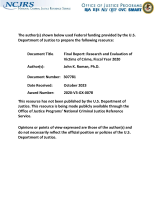A Conceptual Model of Help-Seeking by Black Americans After Violent Injury: Implications for Reducing Inequities in Access to Care
Journal
Prevention Science
Date Published
August 2022
Agencies
NIJ-Sponsored,
OVC-Sponsored
Publication Type
Research (Applied/Empirical)



